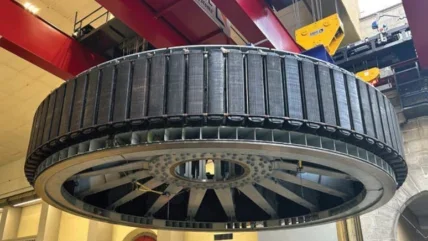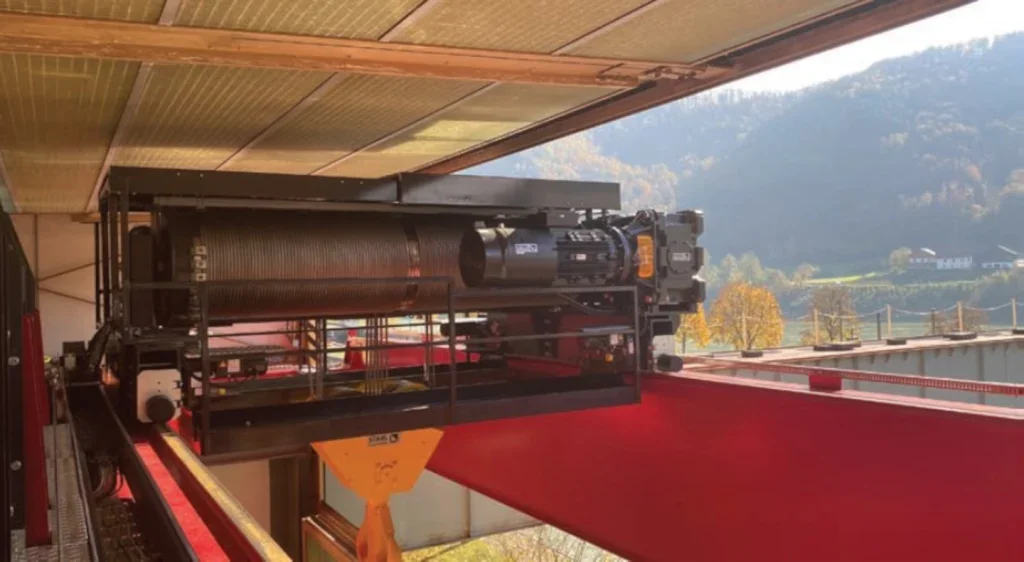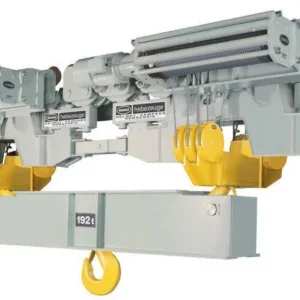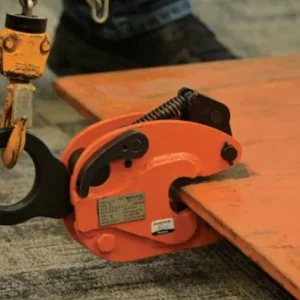
The CraneKit from STAHL CraneSystems has been selected for the modernisation of the crane system at the Jochenstein hydropower plant. The company’s partner – crane and equipment manufacturer Haslinger – was responsible for the complete planning, production, assembly and commissioning. In terms of mechanics and control technology, the new cranes are a truly special solution. Rotors weighing 220t can now be lifted without dismantling the poles.
Germany and Austria have a lot in common, not only in terms of language and culture, sharing Germany’s highest mountain, the Zugspitze, but the small Jochenstein also deserves a mention for several reasons. This rocky island, located on the Danube serving as a border between Germany and Austria, has many legends surrounding it. One of them is that the devil wanted to flood the Austrian market town of Engelhartszell through a wall in the Danube, so he threw a large stone into the river – whether this story is actually true has not been confirmed. However, what is true is that a run-of-the-river hydroelectric power plant is situated there and owes its name to the rocky island of Jochenstein.
The technical facilities of the Jochenstein hydropower plant are located in both Lower Bavaria (market town of Untergriesbach) and in Upper Austria (Engelhartszell). Since 1990, walkers and cyclists have been able to cross the Danube on the weir all year round. The construction of the power plant was planned back in the early 1950s, under the management of Donaukraftwerk Jochenstein AG (DKJ). The first three hydroelectric generating sets went into operation in 1955, followed by two more sets shortly afterwards. In 2013, shares owned by German electricity group E.ON were sold to Verbund in Vienna, Austria, which has operated the plant ever since.
The Jochenstein power plant has a head of just under 10m and, according to official data, has an average annual output of 850,000,000kWh. The movable elements of the weir are located close to the Austrian bank. The ship lock and switchgear are on the Bavarian side. The powerhouse with the turbines sits in the middle of the river on the rocky island.
Regular inspections of the turbines and generators
The five vertical-shaft Kaplan turbines, all of which date back to the 1950s, work in conjunction with five three-phase synchronous generators. Although the rotors in the generators are not directly exposed to the river water, they still have to be lifted out at certain intervals for inspection and maintenance work – for example, to check bearings, windings and other components, correct imbalances and check insulation exposed to thermal stresses for damage and ageing. Cleaning is also required, as dirt and oil residue can accumulate between the rotor and stator. This has to be removed to achieve optimum performance.
A crane system with a lifting capacity of 75,000kg was previously used to move loads – specifically to lift the rotors out of the generators and transport them along the weir, so 150,000kg could be lifted in tandem operation. However, as each individual rotor weighs 220t, all the poles on the rotor had to be dismantled each time they were lifted out to reduce the weight. This took a lot of time, causing high costs for the inspection. Verbund was, therefore, looking for a solution to increase the load capacity of the crane system without dismantling the poles.
STAHL CraneSystems played a key role in the process of developing the new system and throughout the project. Its partner, Haslinger Metallbau + Krantechnik in Aldersbach, Germany, took over the complete planning, production and assembly, and completed the commissioning on schedule in autumn 2024. In the field of welding technology, the Haslinger Group plays in the top division. The company offers complete crane construction package solutions from a single source – from planning, to steel construction and assembly. As a certified partner, Haslinger can call upon the expertise of the STAHL CraneSystems engineering team for all tasks and questions, including PLC programming.
Unchanged crane runway thanks to load-dependent positioning
The challenge at the Jochenstein power station was to increase the load capacity to 120,000kg per crane while maintaining the same wheel loads. In addition, the approach dimensions specified for the old crane system had to be maintained. Furthermore, the span of the crane runway changes when switching from the straight runway section to the curved section. For this reason, the end carriage, which connects the crane girder to the running gear, has a design with special wheels.
In the centre of the crane bridge, the trolley has a travel range of 5,470mm. This range was defined to allow the rotor to be lifted out. The rope drum with a diameter of 800mm is now made of sheet metal instead of the standard 610mm round tube. Lifting beams are used to distribute the load evenly. The wheel loads remain unchanged as the maximum load is limited to the centre of the crane bridge. A special operating mode was set up for this purpose, which allows travel with 120,000kg only in this centre range via a safety circuit. This meant that the old crane runway could be used without any complex modifications, even though the crane can now transport significantly higher loads. Instead of conventional travel limit switches, safety encoders detect the positions of the hoists. These were also used to implement a position-dependent overload detection system, enabling a performance level rating of D to be achieved.

Now, rotors weighing 220t can be lifted out without dismantling the poles. This saves considerable time and reduces the costs of inspecting and maintaining the five generating sets. After being lifted out, the rotor is transported to the opposite side of the Danube, where it is stored for the duration of the inspection. The total crane runway length from the powerhouse to the Austrian bank is around 250m. Its occasional outdoor operation required the system to be specified for an ambient temperature range of -10°C to 40°C.
Double load in tandem operation
In tandem operation, double the load can be lifted, for example, 240t – this is sufficient for the rotors, including their poles. Tandem operation enables efficient handling of the rotors and their safe transportation out of the powerhouse and over the weir. In the past, tandem operation required two experienced crane operators who had to work closely together to navigate the heavy, bulky loads safely and precisely. Today, radio control systems are increasingly being used for tandem lifts to coordinate the movements of the cranes and trolleys, with various operating modes available. The radio remote control is integrated into the crane’s data bus. Both cranes communicate with each other via an industrial WLAN to enable tandem operation.

The cranes have an auxiliary hoist unit with a lifting capacity of 16,000kg, which is used in addition to the main hoist unit and is controlled together with it in tandem trolley mode. The main purpose of the auxiliary hoist is to move loads precisely during delicate lifting operations or assembly work in double-load operation. It enables flexible working, saves time and increases the efficiency of the entire crane system. It is also approved for transporting people as a recovery winch. The auxiliary hoist has two load measurement systems: one for regular loads and one for operating the workman basket. Depending on the operating mode, the signals are processed in the control system.
Mechanics and programming – a special solution
The hoist has load and speed sensors, limit switches and actuators, all of which (apart from the speed sensor) are integrated into the crane’s data bus. Instead of a hard-wired control unit, a programmable KSK-S complete controller is used. This system is modular and expandable, providing options for partial automation. Monitoring when moving the crane or load handling equipment is improved – error messages and operating statuses are output via a specially programmed user interface (Human Machine Interface) and shown on the display.
The new crane system at the Jochenstein hydroelectric power station has been in operation since the autumn of 2024. The new crane is now used for transporting many heavy loads at the Jochenstein hydropower plant. Mechanically and in terms of programming, this is a special solution that was tailor-made for Verbund. A particular advantage of the STAHL CraneKit is its flexibility, which allows it to be easily adapted to the specific requirements of the respective application. The entire rotor was successfully lifted out for the first time at the end of November 2024. Because of the excellent results, further projects with Verbund are in planning.






